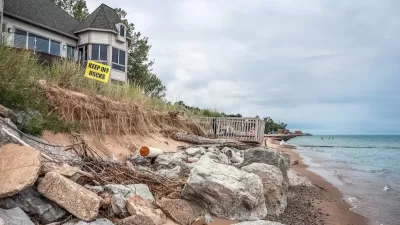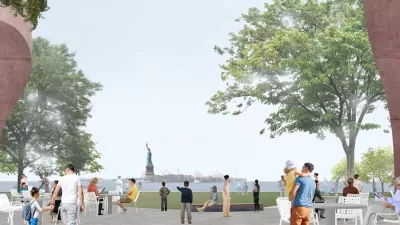Cities around the world are finding ways to protect their residents and infrastructure from the impacts of extreme weather and natural disasters.

In an article for Architecture Daily, Maria-Cristina Florian describes how cities around the world are responding to and preparing for three major types of extreme climate events: flooding, wildfires, and earthquakes.
Florian provides examples of resiliency initiatives from cities facing a variety of threats. In the case of flooding, “Architects and urban planners are now exploring alternatives that rethink stormwater as a resource rather than a hazard, incorporating it into the ecosystem of the city.”
When it comes to wildfires, cities can use mapping to understand high-risk areas. “As peripheric neighborhoods usually have a lower density, they create the ‘wildland-urban interface’ (WUI), an intermediary space typically containing fire fuel, dry material such as fallen leaves. These areas can benefit from the planting of fire-resistant vegetation like low-growing high-moisture plants and hardwood trees with low sap or rising content.” Mitigation strategies also include prescribed burns and building codes that ensure fires are less likely to catch and spread.
To build resilience against earthquakes, “In the areas more prone to seismic activity, structural solutions such as retrofitting with eccentrically braced steel frames, or EBFs, can improve a building’s seismic resilience.”
Florian adds a fourth category: disaster response. “Architects have a role to play, especially in offering fast, efficient, and comfortable solutions for emergency accommodation.” Urban design and architecture can have an effect on how quickly and effectively emergency services can be provided and reached.
FULL STORY: How Can Cities Create Resilience in the Face of Natural Disasters

Alabama: Trump Terminates Settlements for Black Communities Harmed By Raw Sewage
Trump deemed the landmark civil rights agreement “illegal DEI and environmental justice policy.”

Planetizen Federal Action Tracker
A weekly monitor of how Trump’s orders and actions are impacting planners and planning in America.

The 120 Year Old Tiny Home Villages That Sheltered San Francisco’s Earthquake Refugees
More than a century ago, San Francisco mobilized to house thousands of residents displaced by the 1906 earthquake. Could their strategy offer a model for the present?

Ken Jennings Launches Transit Web Series
The Jeopardy champ wants you to ride public transit.

BLM To Rescind Public Lands Rule
The change will downgrade conservation, once again putting federal land at risk for mining and other extractive uses.

Indy Neighborhood Group Builds Temporary Multi-Use Path
Community members, aided in part by funding from the city, repurposed a vehicle lane to create a protected bike and pedestrian path for the summer season.
Urban Design for Planners 1: Software Tools
This six-course series explores essential urban design concepts using open source software and equips planners with the tools they need to participate fully in the urban design process.
Planning for Universal Design
Learn the tools for implementing Universal Design in planning regulations.
Clanton & Associates, Inc.
Jessamine County Fiscal Court
Institute for Housing and Urban Development Studies (IHS)
City of Grandview
Harvard GSD Executive Education
Toledo-Lucas County Plan Commissions
Salt Lake City
NYU Wagner Graduate School of Public Service





























